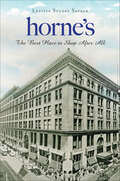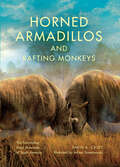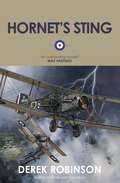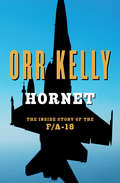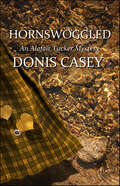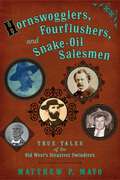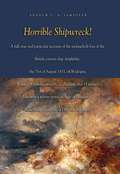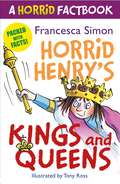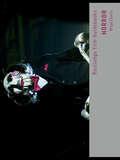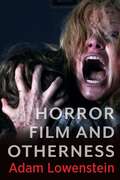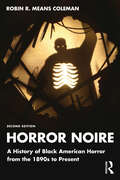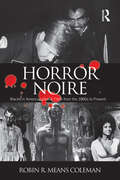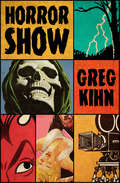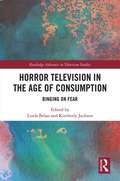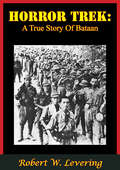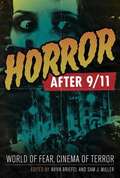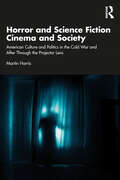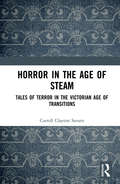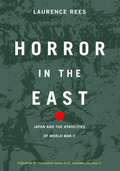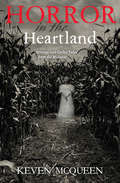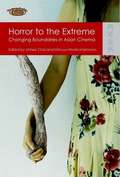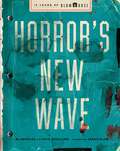- Table View
- List View
Horne's: The Best Place to Shop After All (Landmarks)
by Letitia Stuart SavageThe Joseph Horne Company, popularly known as Horne's, was a beloved and integral part of Pittsburghers' lives for generations.It was the first department store in the Steel City, staking its ground at the landmark flagship store on Penn Avenue and Stanwix Street. Starting as a small dry goods store, the company expanded into a regional retail powerhouse with a reputation for selling high-quality goods in elegant spaces. Horne's succumbed to the fate of other department stores amid changing consumer habits, and a short-lived stint as a Lazarus store was the final chapter in more than 140 years of history. The community still enjoys the tree on the corner of the former Horne's building, now Highmark, that is lit each year to usher in Pittsburgh's holiday season. Author Letitia Stuart Savage shares the history and memories of Horne's department store.
Horned Armadillos and Rafting Monkeys: The Fascinating Fossil Mammals of South America (Life of the Past)
by Darin A. CroftA thrilling guide to the Cenozoic mammals of South America, featuring seventy-five life reconstructions of extinct species, plus photos of specimens and sites.South America is home to some of the most distinctive mammals on Earth—giant armadillos, tiny anteaters, the world’s largest rodent, and its smallest deer. But the continent once supported a variety of other equally intriguing mammals that have no close living relatives: armored mammals with tail clubs, saber-toothed marsupials, and even a swimming sloth. We know of the existence of these peculiar species thanks to South America’s rich fossil record, which provides many glimpses of prehistoric mammals and the ecosystems in which they lived.Organized as a “walk through time” and featuring species from fifteen important fossil sites, this book is the most extensive and richly illustrated volume devoted exclusively to the Cenozoic mammals of South America. The text is supported by seventy-five life reconstructions of extinct species in their native habitats, as well as photographs of fossil specimens and the sites highlighted in the book. An annotated bibliography is included for those interested in delving into the scientific literature.“Well-written and easy for the nonspecialist to understand, this is also a most needed updating of this subject, much in the line of classic works such as Simpson’s The Beginning of the Age of Mammals in South America and Patterson and Pascual’s The Fossil Mammal Fauna of South America.” —Richard Fariña, coauthor Megafauna: Giant Beasts of Pleistocene South America“This handsome book, written by a leading expert in South American paleontology, is profusely illustrated with maps, time charts, color photographs of fossils, and exquisite life reconstructions. The book . . . will appeal to any individual, young and old alike, interested in the fossil record, as well as to students and scholars of paleontology who work in other parts of the globe.” —Choice
Hornet Flight (Core Ser.)
by Ken FollettKen Follett and the intrigue of World War II—"a winning formula" (Entertainment Weekly) if ever there was one. With his riveting prose and unerring instinct for suspense, the #1 New York Times bestselling author takes to the skies over Europe during the early days of the war in a most extraordinary novel. . . . It is June 1941, and the war is not going well for England. Somehow, the Germans are anticipating the RAF's flight paths and shooting down British bombers with impunity. Meanwhile, across the North Sea, eighteen-year-old Harald Olufsen takes a shortcut on the German-occupied Danish island of Sande and discovers an astonishing sight. He doesn't know what it is, but he knows he must tell someone. And when he learns the truth, it will fall upon him to deliver word to England—except that he has no way to get there. He has only an old derelict Hornet Moth biplane rusting away in a ruined church—a plane so decrepit that it is unlikely to ever get off the ground . . . even if Harald knew how to fly it.
Hornet's Sting
by Derek RobinsonIt's 1917, and Captain Stanley Woolley joins an R.F.C. squadron whose pilots are starting to fear the worst: their war over the Western Front may go on for years. A pilot's life is usually short, so while it lasts it is celebrated strenuously. Distractions from the brutality of the air war include British nurses; eccentric Russian pilots; bureaucratic battles over the plum-jam ration; rat-hunting with Very pistols; and the C.O.'s patent, potent cocktail, known as 'Hornet's Sting'. But as the summer offensives boil up, none of these can offer any lasting comfort.
Hornet's Sting
by Derek RobinsonIt's 1917, and Captain Stanley Woolley joins an R.F.C. squadron whose pilots are starting to fear the worst: their war over the Western Front may go on for years. A pilot's life is usually short, so while it lasts it is celebrated strenuously. Distractions from the brutality of the air war include British nurses; eccentric Russian pilots; bureaucratic battles over the plum-jam ration; rat-hunting with Very pistols; and the C.O.'s patent, potent cocktail, known as 'Hornet's Sting'. But as the summer offensives boil up, none of these can offer any lasting comfort.
Hornet: The Inside Story of the F/A-18
by Orr KellyThe fascinating true story of the controversial development and deployment of the supersonic fighter jet that changed aerial warfare foreverThe McDonnell Douglas F/A-18 Hornet was born in 1978, a state-of-the-art supersonic fighter and attack aircraft with a top speed of Mach 1.8, more than one thousand miles per hour. It was versatile, fast, and reliable, and no war machine in the air could match it. The marines adopted it first, followed by the navy, impressed by its incomparable ability to engage in close aerial combat while at the same time efficiently delivering explosive payloads to designated enemy targets. It became the aircraft of choice for the US Navy&’s famous Blue Angels flight demonstration squadron in 1986 and served ably in combat from its first mission—America&’s launched air strike against Libya that same year—through 1991&’s Operation Desert Storm and well beyond. Yet the Hornet has always been shrouded in controversy, and while still in its planning stages, it sparked an unprecedented political battle that nearly doomed the miraculous machine before it could take flight.Orr Kelly, the acclaimed military author who has notably chronicled the remarkable histories of the US Navy SEALs and other branches of America&’s Special Forces, tells the fascinating true story of the F/A-18 Hornet—how it came to be, how it almost wasn&’t, and how it forever altered the way our nation&’s wars are fought.
Hornswoggled (Alafair Tucker Mysteries #2)
by Donis Casey"Donis Casey's voice flows like tea syrup, transporting you effortlessly to the Oklahoma frontier....A welcome invite to your great-grandmother's front porch swing." —JULIA SPENCER-FLEMING, New York Times bestselling authorIt's spring 1913, and love is in bloom for Alice Tucker. Walter Kelley is handsome, popular, and wealthy. But Alice's mother, Alafair, sees that Walter has a weakness for the ladies—and they for him. Only a few months earlier, Walter's late wife Louise had been stabbed in the heart and her body disposed of in Cane Creek. The murderer was never caught.The sheriff cleared Walter of the deed—he had an alibi—but Alafair is not so sure that he wasn't involved in some way. Something literally doesn't smell right.With the help of her feisty mother-in-law, Sally McBride, Alafair sets out to prove to the headstrong Alice that Walter is not the paragon she thinks he is. Alafair soon uncovers such a tangle of lies, misdirection, and deceit that she begins to think that the whole town has been downright hornswoggled!
Hornswogglers, Fourflushers & Snake-Oil Salesmen: True Tales of the Old West's Sleaziest Swindlers
by Matthew P. MayoEveryone loves a heel, especially one to whom nothing was sacred and who charmed his or her way into the hearts, minds, and wallets of bumpkins and belles alike. This collection offers twenty-four tales of petty bandits, sleazy bunko artists, and conniving conmen and –women who traveled West to seek their fortunes by preying on the men and women who went before them to settle and explore. These stories of who they were, what they did, and why they are remembered for their deeds include ample and engaging historic illustrations of the shady characters at work and at play.
Horrible Shipwreck!
by Andrew C. JampolerOn August 25, 1833, the British convict transport Amphitrite, filled with more than one hundred women prisoners and their children, together with a crew of sixteen, left London for the convict colony in New South Wales. Less than a week later, all but three died when a savage storm battered their ship to pieces on a French beach in full sight of hundreds of horrified onlookers. Inexplicably, the captain, John Hunter, had refused offers of aid from the shore. Sensational news coverage of the calamity prompted an Admiralty investigation to find out who was responsible. The suspicion was that Hunter and the surgeon on board rejected assistance because they feared the women would escape custody. Some blamed the doctor s wife because she had refused to go ashore in the same boat with the convicts, so no boat was launched. Others accused the British consul ashore of criminal negligence on the night of the wreck. Colorfully set in the political and social context of early nineteenth-century Great Britain, this account of the shipwreck is peopled with a fascinating cast of characters that includes John Wilks, the Paris correspondent of a London newspaper whose reporting inflamed public emotions; Lord Palmerston, the British foreign secretary; Captain Henry Chads, RN, the Admiralty s investigator; Consul William Hamilton, who was the chief subject of the investigation; Sarah Austin, a British expatriate whose extraordinary heroism the night of the wreck merited an award; and her secret love, a fortune-hunting Prussian prince. Drawing from government records in England, Scotland, and France, and from contemporary newspaper reporting, Andrew Jampoler spins an authentic sea story that rivals the best fiction. Readers will find this work firmly cements Jampoler s reputation as a master storyteller.
Horrid's Henry's Kings and Queens: A Horrid Factbook (Horrid Henry #1)
by Francesca SimonPacked with freaky facts and random trivia, this is the perfect guide to everything you ever wanted to know (and lots of things you might never have wanted to know) about KINGS AND QUEENS - Horrid Henry style!
Horror (Routledge Film Guidebooks)
by Brigid CherryHorror cinema is a hugely successful, but at the same time culturally illicit genre that spans the history of cinema. It continues to flourish with recent cycles of supernatural horror and torture porn that span the full range of horror styles and aesthetics. It is enjoyed by audiences everywhere, but also seen as a malign influence by others. In this Routledge Film Guidebook, audience researcher and film scholar Brigid Cherry provides a comprehensive overview of the horror film and explores how the genre works. Examining the way horror films create images of gore and the uncanny through film technology and effects, Cherry provides an account of the way cinematic and stylistic devices create responses of terror and disgust in the viewer. Horror examines the way these films construct psychological and cognitive responses and how they speak to audiences on an intimate personal level, addressing their innermost fears and desires. Cherry further explores the role of horror cinema in society and culture, looking at how it represents various identity groups and engages with social anxieties, and examining the way horror sees, and is seen by, society.
Horror Film and Otherness (Film and Culture Series)
by Adam LowensteinWhat do horror films reveal about social difference in the everyday world? Criticism of the genre often relies on a dichotomy between monstrosity and normality, in which unearthly creatures and deranged killers are metaphors for society’s fear of the “others” that threaten the “normal.” The monstrous other might represent women, Jews, or Blacks, as well as Indigenous, queer, poor, elderly, or disabled people. The horror film’s depiction of such minorities can be sympathetic to their exclusion or complicit in their oppression, but ultimately, these images are understood to stand in for the others that the majority dreads and marginalizes.Adam Lowenstein offers a new account of horror and why it matters for understanding social otherness. He argues that horror films reveal how the category of the other is not fixed. Instead, the genre captures ongoing metamorphoses across “normal” self and “monstrous” other. This “transformative otherness” confronts viewers with the other’s experience—and challenges us to recognize that we are all vulnerable to becoming or being seen as the other. Instead of settling into comforting certainties regarding monstrosity and normality, horror exposes the ongoing struggle to acknowledge self and other as fundamentally intertwined.Horror Film and Otherness features new interpretations of landmark films by directors including Tobe Hooper, George A. Romero, John Carpenter, David Cronenberg, Stephanie Rothman, Jennifer Kent, Marina de Van, and Jordan Peele. Through close analysis of their engagement with different forms of otherness, this book provides new perspectives on horror’s significance for culture, politics, and art.
Horror Noire: A History of Black American Horror from the 1890s to Present
by Robin R. Means ColemanFrom King Kong to Candyman, the boundary-pushing genre of horror film has always been a site for provocative explorations of race in American popular culture. This book offers a comprehensive chronological survey of Black horror from the 1890s to present day. In this second edition, Robin R. Means Coleman expands upon the history of notable characterizations of Blackness in horror cinema, with new chapters spanning the 1960s, 2000s, and 2010s to the present, and examines key levels of Black participation on screen and behind the camera. The book addresses a full range of Black horror films, including mainstream Hollywood fare, art-house films, Blaxploitation films, and U.S. hip-hop culture-inspired Nollywood films. This new edition also explores the resurgence of the Black horror genre in the last decade, examining the success of Jordan Peele’s films Get Out (2017) and Us (2019), smaller independent films such as The House Invictus (2018), and Nia DaCosta’s sequel to Candyman (2021). Means Coleman argues that horror offers a unique representational space for Black people to challenge negative or racist portrayals, and to portray greater diversity within the concept of Blackness itself. This book is essential reading for anyone seeking to understand how fears and anxieties about race and race relations are made manifest, and often challenged, on the silver screen.
Horror Noire: Blacks in American Horror Films from the 1890s to Present
by Robin R Means ColemanFrom King Kong to Candyman, the boundary-pushing genre of the horror film has always been a site for provocative explorations of race in American popular culture. In Horror Noire: Blacks in American Horror Films from 1890's to Present, Robin R. Means Coleman traces the history of notable characterizations of blackness in horror cinema, and examines key levels of black participation on screen and behind the camera. She argues that horror offers a representational space for black people to challenge the more negative, or racist, images seen in other media outlets, and to portray greater diversity within the concept of blackness itself. Horror Noire presents a unique social history of blacks in America through changing images in horror films. Throughout the text, the reader is encouraged to unpack the genre’s racialized imagery, as well as the narratives that make up popular culture’s commentary on race. Offering a comprehensive chronological survey of the genre, this book addresses a full range of black horror films, including mainstream Hollywood fare, as well as art-house films, Blaxploitation films, direct-to-DVD films, and the emerging U.S./hip-hop culture-inspired Nigerian "Nollywood" Black horror films. Horror Noire is, thus, essential reading for anyone seeking to understand how fears and anxieties about race and race relations are made manifest, and often challenged, on the silver screen.
Horror Show (Special Warfare Ser.)
by Greg KihnA Bram Stoker Award finalist for Best First Novel: This endlessly inventive thriller pays homage to 1950s Hollywood horror films--with a demonic twist Schlock horror director Landis Woodley lives in a decaying mansion in the Hollywood Hills. When he abandoned the movie business--after being reduced to filming skin flicks and peep shows--he also left a laundry list of enemies, including the IRS. But avid fan Clint Stockbern is determined to write a piece on the alcoholic recluse for Monster magazine. Woodley agrees to the interview--for $600 in cash. As the tape recorder starts rolling, Stockbern travels back in time with Woodley. He hears recollections of Attack of the Haunted Saucer, the worst movie of all time, and Blood Ghouls of Malibu. But he really wants to know about Woodley's masterpiece, Cadaver. Shot on location in the Los Angeles County morgue, the film was rumored to have used real corpses and everyone associated with the production has been fatally haunted since its 1957 release. But the truth is far more terrifying than Stockbern imagined. Is a dead Satanist, possessed by the devil, reaching out beyond the grave? Or is the reporter the final victim in a diabolical scheme dreamed up by mortals? Horror Show is a wild and wacky romp that sends up mid-century Hollywood horror movies and schlockmeisters Roger Corman, William Castle, and Ed Wood.
Horror Television in the Age of Consumption: Binging on Fear (Routledge Advances in Television Studies)
by Kimberly Jackson Linda BelauCharacterized as it is by its interest in and engagement with the supernatural, psycho-social formations, the gothic, and issues of identity and subjectivity, horror has long functioned as an allegorical device for interrogations into the seamier side of cultural foundations. This collection, therefore, explores both the cultural landscape of this recent phenomenon and the reasons for these television series’ wide appeal, focusing on televisual aesthetics, technological novelties, the role of adaptation and seriality, questions of gender, identity and subjectivity, and the ways in which the shows’ themes comment on the culture that consumes them. Featuring new work by many of the field’s leading scholars, this collection offers innovative readings and rigorous theoretical analyses of some of our most significant contemporary texts in the genre of Horror Television.
Horror Trek: A True Story Of Bataan
by Robert W. LeveringThis record of the personal experiences and first-hand knowledge of the early days of the war in the Philippines; the tragic defense of Bataan; the horrors of the Death March; the sadistically planned and executed inhuman sufferings forced upon the valiant survivors of the operations of war, doomed to a life or death existence as so-called prisoners of war, is vividly portrayed in these pages called "Horror Trek."The author, Robert W. Levering, through love of country and inherent natural instincts of character and principle, elected to follow his comrades in arms to the field of battle rather than accept the comparative safety offered to civilian internees in "Santo Tomas."
Horror after 9/11
by Aviva Briefel Sam J. MillerHorror films have exploded in popularity since the tragic events of September 11, 2001, many of them breaking box-office records and generating broad public discourse. These films have attracted A-list talent and earned award nods, while at the same time becoming darker, more disturbing, and increasingly apocalyptic. Why has horror suddenly become more popular, and what does this say about us? What do specific horror films and trends convey about American society in the wake of events so horrific that many pundits initially predicted the death of the genre? How could American audiences, after tasting real horror, want to consume images of violence on screen? Horror after 9/11 represents the first major exploration of the horror genre through the lens of 9/11 and the subsequent transformation of American and global society. Films discussed include the Twilight saga; the Saw series; Hostel; Cloverfield; 28 Days Later; remakes of The Texas Chainsaw Massacre, Dawn of the Dead, and The Hills Have Eyes; and many more. The contributors analyze recent trends in the horror genre, including the rise of ‘torture porn,’ the big-budget remakes of classic horror films, the reinvention of traditional monsters such as vampires and zombies, and a new awareness of visual technologies as sites of horror in themselves. The essays examine the allegorical role that the horror film has held in the last ten years, and the ways that it has been translating and reinterpreting the discourses and images of terror into its own cinematic language.
Horror and Science Fiction Cinema and Society: American Culture and Politics in the Cold War and After Through the Projector Lens
by Martin HarrisExamining how horror and science fiction films from the 1950s to the present invent and explore fictional “us-versus-them” scenarios, this book analyzes the different ways such films employ allegory and/or satire to interrogate the causes and consequences of increasing polarization in American politics and society.Starting with the killer ants film with an anti-communist subtext Them! (1954) and concluding with Jordan Peele’s social horror film with revenge-seeking homicidal doppelgängers Us (2019), Martin Harris highlights social and political contexts, contemporary reviews and responses, and retrospective evaluations to show how American horror and science fiction films reflect and respond to contemporary conflicts marking various periods in U.S. history from post-WWII to the present, including those concerning race, gender, class, faith, political ideology, national identity, and other elements of American society.Horror and Science Fiction Cinema and Society draws upon cinematic sociology to provide a resourceful approach to American horror and science fiction films that integrates discussion of plot construction and character development with analyses of the thematic uses of conflict, guiding readers’ understanding of how filmmakers create otherworldly confrontations to deliver real-world social and political commentary.
Horror in Paradise
by James Cornell[from the back cover] "For almost a month Mt. Pelée, the long-dormant volcano towering over the city of St Pierre on the island of Martinique, had been sending out warning signals: clouds of thick yellow-brown smoke, loud rumbles, avalanches of mud and rocks that crushed trees and rooftops in the surrounding countryside. At night the sky glowed with a brilliant ominous red. The experts poohpoohed these warnings. The Governor of the island listened to the experts. No evacuation of the city was ordered. Then, on the morning of May 8, 1902, at 7:50 A.M. Mt. Pelée awoke with a vengeance. An explosion heard for hundreds of miles poured flaming gases and jets of superheated steam down onto the sleeping city, turning it into a living hell. By 7:53 A.M. all but three of its 30,000 inhabitants were dead. Of these three survivors, two died within hours. The third was a convicted murderer awaiting execution in a dungeon deep beneath the city jail. The only survivor of St Pierre was a man condemned to die! 30 dramas of death and destruction. And they're all true!"
Horror in the Age of Steam: Tales of Terror in the Victorian Age of Transitions
by Carroll Clayton SavantChange is terrifying, and rapid change, within a small amount of time, is destabilizing to any culture. England, under the tutelage of Queen Victoria, witnessed precipitous change the likes of which it had not encountered in generations. Wholesale swaths of the economy and the social structure underwent complete recalibration, through the hands of economic progress, industrial innovation, scientific discovery, and social cohesiveness. Faced with such change, Britons had to redefine the concept of work, belief, and even what it meant to be English. Victorians relied on many methods to attempt to release the steam from the anxieties incurred through change, and one of those methods was the horror story of everyday existence during an age of transition. This book is a study of how authors Elizabeth Gaskell, Emily Brontë, and Anne Brontë turned to horrifying representations of everyday reality to illustrate the psychological-traumatic terrors of an age of transition
Horror in the East: Japan and the Atrocities of World War II
by Laurence ReesIn the tradition of the best-selling Rape of Nanking, a provocative examination of Japanese atrocities during World War II. Another stunning slice of history from Laurence Rees. -Daily Telegraph
Horror in the Heartland: Strange and Gothic Tales from the Midwest
by Keven McQueenA spooky history of the American Midwest—from grave robbers to ghost sightings and more—by the author of Creepy California. Most people think of the American Midwest as a place of wheat fields and family farms; cozy small towns and wholesome communities. But there&’s more to the story of America&’s Heartland—a dark history of strange tales and unsettling facts hidden just beneath its quaint pastoral image. In Horror in the Heartland, historian Keven McQueen offers a guided tour of terrible crimes and eccentric characters; haunted houses and murder-suicides; mad doctors, body snatchers, and pranks gone comically—and tragically—wrong. From tales of the booming grave-robbing industry of late 19th-century Indiana to the story of a Michigan physician who left his estate to his pet monkeys, McQueen investigates a spooky and twisted side of Indiana, Ohio, Kansas, Nebraska, Iowa, Minnesota, Wisconsin, and Michigan. Exploring burial customs, unexplained deaths, ghost stories, premature burials, bizarre murders, peculiar wills and much more, this creepy collection reveals the region&’s untold stories and offers intriguing, if sometimes macabre, insights into human nature.
Horror to the Extreme
by Jinhee Choi Mitsuyo Wada-MarcianoThis book compares production and consumption of Asian horror cinemas in different national contexts and their multidirectional dialogues with Hollywood and neighboring Asian cultures. Individual essays highlight common themes including technology, digital media, adolescent audience sensibilities, transnational co-productions, pan-Asian marketing techniques, and variations on good vs. evil evident in many Asian horror films. Contributors include Kevin Heffernan, Adam Knee, Chi-Yun Shin, Chika Kinoshita, Robert Cagle, Emilie Yeh Yueh-yu, Neda Ng Hei-tung, Hyun-suk Seo, Kyung Hyun Kim, and Robert Hyland.
Horror's New Wave: 15 Years of Blumhouse
by BlumhouseCelebrate legendary horror studio Blumhouse&’s legacy with this lavishly illustrated visual compendium that takes you behind the scenes of the films that have reshaped the horror genre, from The Exorcist to the Paranormal Activity and Halloween franchises.With Blumhouse celebrating its 15th anniversary throughout 2025, Horror&’s New Wave captures the company&’s journey to become a powerhouse in the horror and thriller film genres—taking you through the process of conception to premiere for films like Five Nights at Freddy&’s, Sinister, Split, Get Out, M3GAN, now-classic franchises like The Purge, and so much more. This definitive &“Blumhouse book&” delves into the behind-the-scenes processes that shaped Blumhouse&’s iconic films and is perfect for cinephiles, pop culture enthusiasts, and lovers of horror. Featuring an introduction from CEO and founder Jason Blum, it also includes interviews with key filmmakers and writers like M. Night Shyamalan, Leigh Whannell, James Wan, and Mike Flanagan; actors, such as Allison Williams, Ethan Hawke, Jamie Lee Curtis, and Octavia Spencer; and Blumhouse executives like head of film Couper Samuelson and head of casting Terri Taylor. These interviews explore how each project came together, offering stories and insights into the creative process, such as directing, musical score, makeup, acting, cinematography, and more. You will get a birds-eye view at the triumphs and challenges of some of the most beloved and iconic horror films of all time. This book also includes film stills, on-set photographs, storyboards, creative briefs, and title treatments—giving you a true backstage pass to the making of your favorite films.
